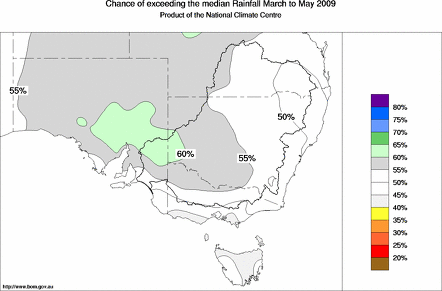| Southeastern Aust Seasonal Rainfall Outlook: probabilities for Autumn 2009, issued 20th February 2009 | |||||||||
Wetter than average conditions indicated for parts of South Australia and southwestern NSWThe outlook for rainfall during autumn (March to May) shows a moderate shift in the odds favouring wetter than normal conditions over eastern parts of South Australia and the far southwest of NSW. The pattern of seasonal rainfall odds across South East Australia is mainly a result of warm conditions in the Indian Ocean in January; the Pacific Ocean has had little contribution to this forecast. 
North eastern agricultural and southern pastoral areas of South Australia, along with an adjacent area in the far southwest of New South Wales have over a 60% chance of exceeding the 3-month median rainfall. This means for every ten years with ocean patterns like the current, about six years are expected to be wetter than average for these areas while about four years are expected to be drier. Over the remainder of NSW and South Australia, and over all of Victoria and Tasmania the chances of exceeding the seasonal median are between 40% and 60%. This means the chances of being wetter than normal in these areas are about the same as the chances of being drier. Outlook confidence is related to how consistently the Pacific and Indian Oceans affect southeast Australian rainfall. During March to May, history shows this effect to be generally weakly to very weakly consistent over most of southeast Australia, while being moderately consistent only in patches, mainly in northern South Australia and western Tasmania (see background information)). Therefore, caution should be used when interpreting this outlook. Some warming of the equatorial Pacific Ocean occurred in January, following cooling in December, so that sea surface temperatures (SST) in the central Pacific have now eased back to neutral values. While sub-surface waters are cool in the eastern Pacific, those in the west of the basin are warmer than normal and there are indications that these will impact on the surface in coming months. Furthermore, most current model outlooks suggest further warming in the Pacific. The most likely scenario is for conditions to remain neutral. The SOI remains positive at approximately +15 for the 30 days ending 17 February. For routine updates and comprehensive discussion on any developments please see the ENSO Wrap-Up. | |||||||||
Click on the map above for a larger version of the map. Use the reload/refresh button to ensure the latest forecast map is displayed. More detailed forecast maps, including the probabilities of seasonal rainfall exceeding given totals, can be found here. | |||||||||
|
More information on this outlook is available Monday to Friday from 9.00am to 5.00pm local time by contacting the Bureau's Climate Services sections in Queensland, NSW, SA, Victoria and Tasmania at the following numbers:
| |||||||||
THE NEXT ISSUE OF THE SEASONAL OUTLOOK IS EXPECTED BY 24th March 2009 Corresponding temperature outlook January 2009 rainfall in historical perspective November 2008 to January 2009 rainfall in historical perspective | |||||||||
Background Information
| |||||||||









